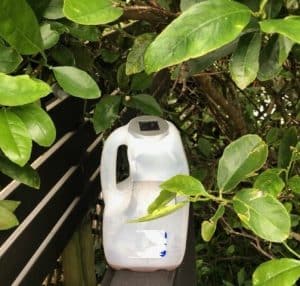Do you have a guava moth infestation? You’ll be able to tell as your fruit will fall early from the tree and upon inspection you’ll see a little hole, often the area around the hole will be soft and when you cut it open you’ll see the culprit; guava moth larvae.
One way to stop the moths is to make a trap, this idea was sent in by one of our subscribers, Megan, it’s much easier to make than the version I shared a couple of years ago.
The guava moth lays its eggs on the outside of the fruit and when hatched the larvae burrow inside, they’ll do this on a range of fruit and nut plants including guavas, citrus, loquats, apples, peaches, plums, pears, macadamias and feijoas, and unfortunately, they breed all year round.
To make this trap you place a solar light in the top of a milk bottle and cut a flap cut into the side for the moths. The moth solution goes in the bottom of the milk bottle.
Milk Bottle Solar Guava Moth Trap
1 litre of boiling water
1/3 cup of sugar
1 tsp Vanilla Essence (the cheap variety is fine)
1 tsp Marmite
1 tsp ammonia (Handy Andy is fine)
Mix all the ingredients together until the Marmite and sugar have dissolved, let cool.

To make the traps: cut a flap into the side of the plastic milk bottles, designed to push inwards and downwards. This enables to moths to get into the container, whilst restricting rain.
Remove the milk bottle cap and either push your solar light into the top of the milk bottle, or cut out a section so that the solar light sits on top of the bottle (if you are using this method you’ll need to turn the light on and then glue it into place).

Measure out the liquid between your bottles and place the bottle near fruit trees, ensuring that the lights are on. Refill the mixture every so often.
This quantity is enough for 4 x 2 litre milk bottles, so you will need to reduce or multiply the recipe as required.
Thanks to Mary for updating Megan’s recipe with the quantities.
Along with the traps, try spraying plants with a Neem Oil solution before blossoming, then again when the petals drop, and every two weeks after to control pests. Make your solution with two teaspoons of Neem to one litre of warm water mixed with one teaspoon of natural dish wash liquid. Make the spray fresh each time and if you have any left over spray on leaves and around the base too.
To help keep the Guava Moth away you can also plant lavender, borage, echinacea, alyssum or hyssop near the fruiting trees as these attract beneficial predator insects.





About The Author: Triona
More posts by Triona